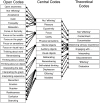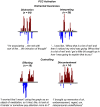Effortless awareness: using real time neurofeedback to investigate correlates of posterior cingulate cortex activity in meditators' self-report
- PMID: 23964222
- PMCID: PMC3734786
- DOI: 10.3389/fnhum.2013.00440
Effortless awareness: using real time neurofeedback to investigate correlates of posterior cingulate cortex activity in meditators' self-report
Abstract
Neurophenomenological studies seek to utilize first-person self-report to elucidate cognitive processes related to physiological data. Grounded theory offers an approach to the qualitative analysis of self-report, whereby theoretical constructs are derived from empirical data. Here we used grounded theory methodology (GTM) to assess how the first-person experience of meditation relates to neural activity in a core region of the default mode network-the posterior cingulate cortex (PCC). We analyzed first-person data consisting of meditators' accounts of their subjective experience during runs of a real time fMRI neurofeedback study of meditation, and third-person data consisting of corresponding feedback graphs of PCC activity during the same runs. We found that for meditators, the subjective experiences of "undistracted awareness" such as "concentration" and "observing sensory experience," and "effortless doing" such as "observing sensory experience," "not efforting," and "contentment," correspond with PCC deactivation. Further, the subjective experiences of "distracted awareness" such as "distraction" and "interpreting," and "controlling" such as "efforting" and "discontentment," correspond with PCC activation. Moreover, we derived several novel hypotheses about how specific qualities of cognitive processes during meditation relate to PCC activity, such as the difference between meditation and "trying to meditate." These findings offer novel insights into the relationship between meditation and mind wandering or self-related thinking and neural activity in the default mode network, driven by first-person reports.
Keywords: grounded theory; introspection; meditation; neurophenomenology; posterior cingulate cortex; real time fMRI; self-referential processing; self-report.
Figures





References
-
- Birks M., Mills J. (2011). Grounded Theory: A Practical Guide. Los Angeles, CA: SAGE Publications Ltd
LinkOut - more resources
Full Text Sources
Other Literature Sources

